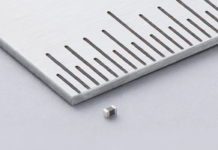
Littelfuse, Inc. (NASDAQ: LFUS), a diversified, industrial technology manufacturing company empowering a sustainable, connected, and safer world, announced the launch of two next-generation Tunneling Magnetoresistance (TMR) magnetic switches: the LF21112TMR omnipolar switch and the LF11215TMR bipolar switch. These compact devices offer exceptional magnetic sensitivity, thermal stability, and ultra-low power consumption—providing energy-efficient sensing solutions for smart meters, wearables, consumer electronics, industrial automation, and home security systems. (View the video in English, Chinese & Japanese.)
Expanded TMR Sensor Portfolio
By integrating TMR technology with ultra-low-power CMOS design, both switches deliver superior performance compared to traditional Hall-effect sensors and older magnetic switch technologies. These introductions mark a significant expansion of the Littelfuse magnetic sensor portfolio into battery-sensitive and always-on applications.
- LF21112TMR: The company’s first omnipolar TMR switch, capable of detecting both North and South magnetic poles, enables greater flexibility in magnet placement and simplifies design. With a typical current draw of just 200nA, it is ideal for ultra-low-power applications.
- LF11215TMR: A bipolar digital TMR switch that delivers high-speed, precision detection with ultra-low 1.5 µA current consumption and a high magnetic sensitivity of just 17 Gauss. It excels at more complex sensing applications that require directional detection.
Bipolar vs. Omnipolar: What’s the Difference?
Omnipolar switches, such as the LF21112TMR, trigger a response when exposed to either magnetic pole, making them ideal for space-constrained designs and applications where it is harder to control the magnet alignment.. Bipolar switches, such as the LF11215TMR, are triggered by a specific magnetic polarity (typically North), and reset with the opposite polarity (South). This directional sensitivity is advantageous for applications needing rotational or directional sensing.
Key Features and Benefits
Both devices are housed in compact SOT23-3 packages and feature:
- TMR technology for higher sensitivity and thermal stability
- Push-pull CMOS output for clean digital signals
- Schmitt trigger inputs to reduce noise and improve reliability
- Excellent immunity to external magnetic interference
- Wide operating voltage: 1.8V to 5.0V
These switches help engineers design smaller, smarter, and more energy-efficient products while reducing mechanical complexity and extending battery life.
Markets and Applications
These innovative switches are ideal for:
- Smart utility meters (gas, water, heat)
- Battery-powered wearables and IoT sensors
- Lid and cover detection in appliances and power tools
- Tamper detection in home and building automation
- Rotary and linear position sensing in light industrial and robotic equipment
“With the LF21112TMR and LF11215TMR, we’re expanding the Littelfuse TMR sensor portfolio with solutions that address critical design challenges in today’s compact, battery-powered, and always-on devices,” said Julius Venckus, Global Product Manager at Littelfuse. “Both switches integrate Tunneling Magnetoresistance technology with ultra-low power CMOS design, delivering exceptional magnetic sensitivity and thermal stability at industry-leading current levels—just 200nA for omnipolar sensing and 1.5 µA for bipolar. These innovations empower engineers to extend battery life, simplify magnetic alignment, and ensure reliable sensing in noisy, thermally demanding environments. Whether you need flexible pole detection or precise directional switching, these TMR solutions offer the performance and efficiency required to design smarter, longer-lasting applications—from smart meters and wearables to factory automation and home security systems.”
Frequently Asked Questions: TMR Magnetic Switches
1. What advantages do TMR switches offer over Hall-effect sensors?
Tunneling Magnetoresistance (TMR) switches deliver much higher magnetic sensitivity and dramatically lower power consumption than Hall-effect sensors. This combination extends battery life and ensures reliable sensing performance in compact, always-on designs like smart meters and wearables.
2. How do omnipolar and bipolar TMR switches differ?
Omnipolar switches, such as the LF21112TMR, respond to either magnetic pole, simplifying alignment and offering greater design flexibility. Bipolar switches, like the LF11215TMR, activate with one pole and reset with the opposite, enabling precise directional or rotational sensing.
3. What makes these switches ideal for battery-powered and IoT devices?
Their ultra-low current draw—just 200 nA for the omnipolar and 1.5 µA for the bipolar—makes them ideal for energy-sensitive applications. With integrated CMOS design, they maintain high responsiveness while extending product operating life in wearables, sensors, and metering devices.
4. Which applications benefit most from the LF21112TMR and LF11215TMR?
These switches are ideal for battery-powered applications and space-constrained environments such as smart utility meters, wearables, IoT devices, appliances, and automation systems. Their compact SOT23-3 packaging, wide 1.8–5.0 V operating range, and robust magnetic immunity support easy integration into modern compact electronics.
5. Can these TMR switches replace Hall-effect sensors in existing designs?
Yes. Both models can often drop into existing Hall-effect switch circuits without major redesign. The push-pull CMOS output and standard SOT23-3 footprint simplify substitution, while the wide voltage range and enhanced sensitivity help engineers upgrade performance and reduce power draw. The TMR activation direction is on the “X” axis, while the Hall effect is on the “Z” axis.
Availability
They are available in tape-and-reel format in quantities of 3000 pieces. Sample requests are accepted through authorized Littelfuse distributors worldwide. For a listing of Littelfuse distributors, please visit Littelfuse.com.
For More Information
Additional information is available on the LF21112TMR omnipolar switch and the LF11215TMR bipolar switch product pages. For technical questions, please contact: Julius Venckus, Global Product Manager, jvenckus@littelfuse.com.

















